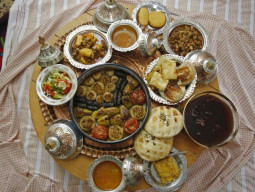
Even more intriguing to some that so many in Pakistan are malnourished. Stunting, wasting, being underweight or overweight, or even obese, are all serious issues, well documented in the press. Hidden hunger for essential micronutrients, including iron, vitamin A and zinc, is rife in Pakistan.
The 2017 State of Food Insecurity and Nutrition in the World report, a just released UN publication, says that 19.9 per cent of the total population in Pakistan was undernourished during 2014-2016. The same report reveals that the global figure for stunting (low height for age) in young children has now reduced to one in four. But in Pakistan the figure is closer to one in two.
With the marking of World Food Day on 16 October, it is worth reflecting why the country is in this predicament, and what it means for our future.
On the surface, we have a surplus of staple grains produced and even exported. There is plentiful rice and wheat, in spite of the rapidly growing population, now over 207 million. But food sovereignty is not the whole story. Humans cannot live on simply bread, or even on just rice. And increasingly, Pakistan is not producing its important crops at an internationally-competitive price, making the goal of food self-sufficiency one of doubtful value. Further, the public stockholdings held by the government for supplying food in emergencies cannot arrest the structural causes of hunger and malnutrition.

As any doctor will tell you, we require an ongoing, balanced diet for optimum health, growth and nutrition. So the availability of other foods, whether imported or domestically produced, is a significant factor. Aside from availability, high food prices in Pakistan, especially of high-nutrient items like vegetables, fruits, milk, meat, fish, pulses and eggs, continue to make it hard for the poor, who spend the majority of their incomes on food.
Even the basics, like flour and oil, are expensive when we take into account the income of the common person, for whom the minimum wage has been set at Rs15,000 a month. While nutritious foods like fruit or fresh milk are often cheaper in rural areas than urban, the opposite is true for many of the processed food items people use, like cooking oil, powdered milk, sugar and tea. The Ministry of Planning, Development and Reform’s published figures for the minimum cost of diet per month in Pakistan say it varies from Rs2,061 per head in Punjab to Rs2,415 in Balochistan. So inaccessibility of food, due to its price, is a key factor in Pakistan’s food insecurity.
Pakistan is, fortunately, now a middle income country, ever since the 2000s. But the uneven distribution of capital and opportunity in Pakistan continue to mean the benefits do not reach everyone. The Government of Pakistan reported in its 2015-16 Economic Survey that 38.8 per cent of Pakistanis, or nearly two-fifths, were living in multi-dimensional poverty. Multi-dimensional poverty is a measure which reflects not only income and assets, but the deprivations people experience in health, education and living standards. This is important because such deprivation is showing up as playing a major role in both food insecurity and nutrition insecurity.
What this means is that even if a farmer were surrounded by a bountiful field of fruit trees, vegetables, wheat, goats, chickens and the like, her nutritional well-being and that of her family cannot be taken for granted. If she lacks access to toilets and clean drinking water, or a functional kitchen allowing good hygiene, then illnesses like diahrroea are more likely, and with them, malnutrition. If there is no primary medical care nearby, or any skilled birthing attendants, then the chances go up of sick and malnourished babies and children. If there is no secondary school for her daughters and sons, or the primary school does not have any resources, then we can foresee reduced literacy and knowledge. Knowledge of how to obtain a balanced diet, how to maintain hygiene and food safety, how to diversify one’s income and employment opportunities, and even how to farm more productively and efficiently.
The sad thing is that a stunted child in Pakistan has a bleak future. Stunting is considered irreversible by the age of two. Knock-on effects can include early mortality, cognitive impairment and ongoing health issues. To have half the workforce in this situation, and the mothers of future Pakistani children undernourished in this way, simply eats away at Pakistan’s future. Malnutrition is estimated to cost three per cent of Pakistan’s GDP every year.
Urgent work is still needed on modernising the agriculture sector, training its workforce in the efficient production of nutritious food, and bringing down the cost of the minimum diet. Climate-smart agricultural methods and the use of a technologically-savvy agricultural extension system can lead the way. But without attention to further improvement of Pakistan’s multi-dimensional poverty problems, we will not see the full potential of these changes realised.
Published in The Express Tribune, October 10th, 2017.
Like Opinion & Editorial on Facebook, follow @ETOpEd on Twitter to receive all updates on all our daily pieces.







































COMMENTS
Comments are moderated and generally will be posted if they are on-topic and not abusive.
For more information, please see our Comments FAQ